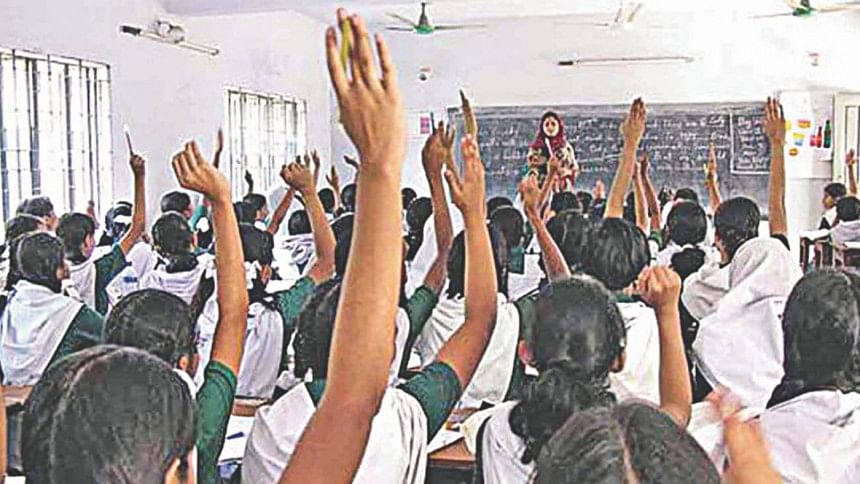What can we do to keep children in school?

Student absenteeism (in the classroom) is a matter of serious concern for education policymakers in Bangladesh because it is a major hindrance in achieving Sustainable Development Goal 4 (SDG 4), the objective of which is to "ensure inclusive and equitable quality education and promote lifelong learning opportunities for all." The phenomenon is noticeable in both primary and tertiary level educational institutions.
A Unicef report published in 2009 (entitled "Quality Primary Education in Bangladesh") claimed that student absenteeism in Bangladesh was 19 percent at the primary level. The percentage was an average figure for both public and private primary schools. In fact, if it is accounted for public schools only, the figure might be over 19 percent. In private schools, student absenteeism is relatively low, because private schools penalise students who remain absent in class without valid reason. Some private schools use it as a source of income. As a result, students attend school to avoid fines or penalties. My daughter and son attend a private college and a school in Dhaka city, where the authorities charge a fine of Tk 2,000 and Tk 300 respectively for each day that they are absent without a valid reason acceptable to the school authorities. But government schools are unable to exercise the practice within the given legal framework.
The driving factors behind student absenteeism are multifaceted including students' poor socioeconomic conditions and perceptions of parents towards education and their future expectations. In government schools and colleges, the majority of students hail from a poor background. Although at the primary level, education is free, this "free" education too has a cost. Some researchers estimated that the annual private expenditure per student, on average, accounts for 54 percent of the total annual expenditure per student in non-government registered madrasas and 59 percent in government schools, while it is as high as 88 percent in non-government non-registered madrasas, 82 percent in non-government non-registered schools, and 77 percent in non-government registered schools. In rural areas, families shoulder an average of 63 percent of the cost burden, or nearly Tk 2,200 per year. Per student expenditure among families from the wealthiest quintile was nearly two and a half times more than that of households in the poorest quintile.
In addition, there are costs from the supply-side. The cost involves salary and benefits for the teaching staff and overhead costs to run the school. To mitigate the financial pressure, the government has undertaken a stipend programme. The stipend programme in government-funded schools provides families with Tk 120/year (USD 16) for one child, and only marginally more for additional children which is insufficient to meet the household's education costs. Consequently, low-income people prefer "work in the field" to education for their schoolgoing children.
In order to retain students in the school, the government runs the "school feeding programme" to provide primary students mid-day meals in schools. Despite that, student absenteeism shows no signs of ending. It may have something to do with the perception of many students and their parents towards education in government primary schools. They believe that teachers in government primary schools do not teach at all; they either sleep in class during classtime or waste time gossiping. In some research studies it has been found that Bangladesh's average annual classroom contact time in government-funded schools is one of the lowest in the world, which was 587 hours per year compared to 1,200 hours per year in China for example (during 2000-2001).
Although the primary education subsector has witnessed many policy reforms being implemented under different donor-assisted projects, perhaps none of them has had any effect on the abovementioned issue of classroom contact time. The projects bring on board numerous international and national consultants for suggestions as to what to do and what not to do without any accountability or evidence of effectiveness. It is thus worth reviewing what we know about the causes, consequences, and potential solutions for absenteeism.
Researchers categorise the underlying causes of absenteeism into four groups: (i) student-specific factors such as poor academic performance and repeating subjects, lack of caring relationships with adults, negative peer influence, bullying; (ii) family-specific factors such as low family income, low parent involvement, at-home responsibilities, stressful family events conflicting with home and school priorities, language differences; (iii) school-specific factors such as poor conditions or lack of school facilities, teachers of poor quality, shortage of teachers, poor student-teacher interactions, lack of geographical access to school, lack of challenging courses and student boredom; and (iv) community-specific factors such as availability of job opportunities that do not require formal schooling, unsafe neighbourhoods, low compulsory educational requirements, lack of social and educational support services. The projects undertaken by the government so far barely influence the above four areas.
If student absenteeism continues, achieving SDG 4 will remain a far cry. The information readily available for policymaking is often unsuitable, either because the rigorous research required to identify policy needs has not yet been conducted, or because the research that is available is contradictory and does not suggest a single course of action. It is thus crucial that educational policy decisions are made based on the most reliable evidence possible.
Shamsul Arifeen Khan Mamun, PhD, is an education economist and is the head of the Department of Economics, Moulvibazar Government College.
Email: [email protected]





Comments